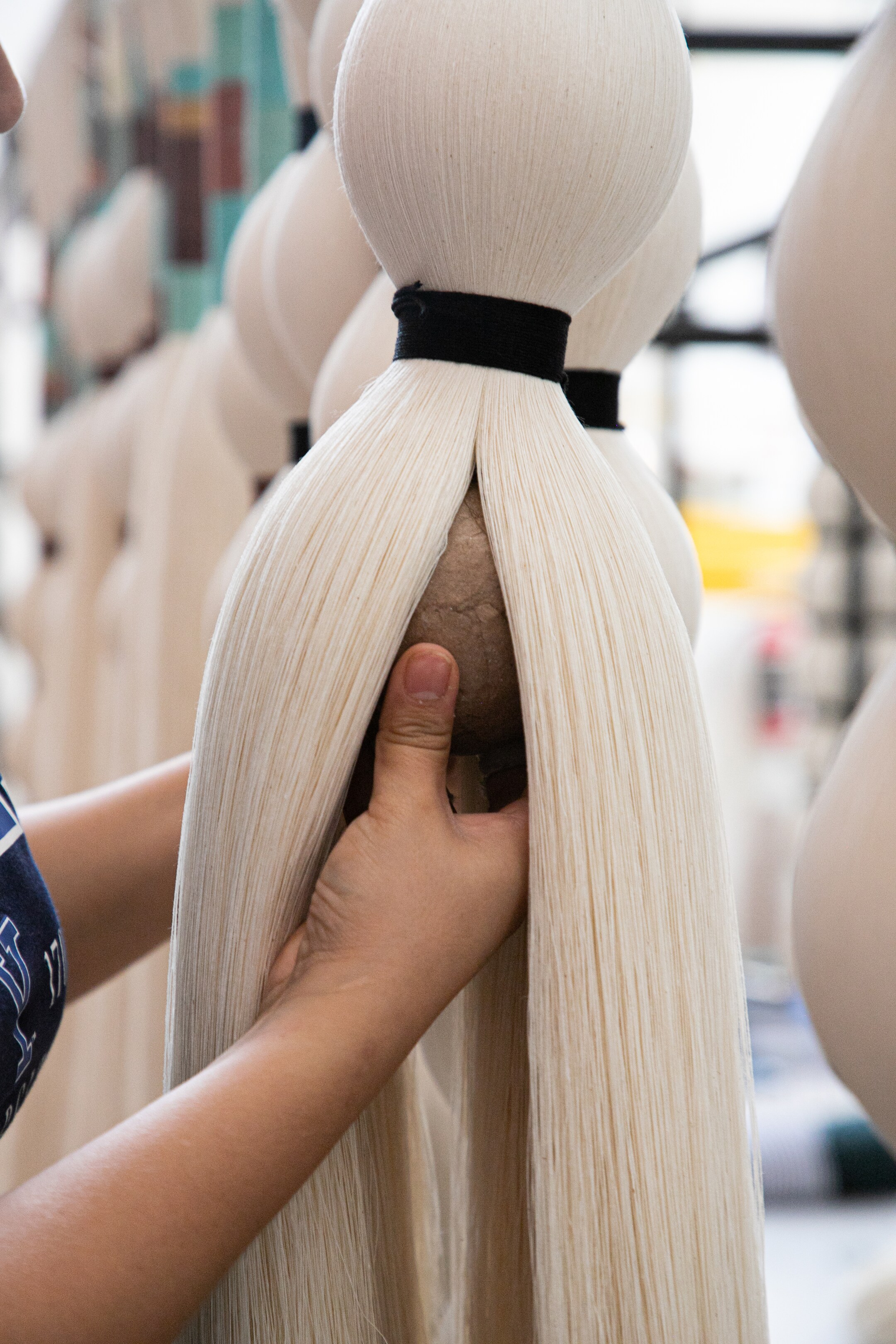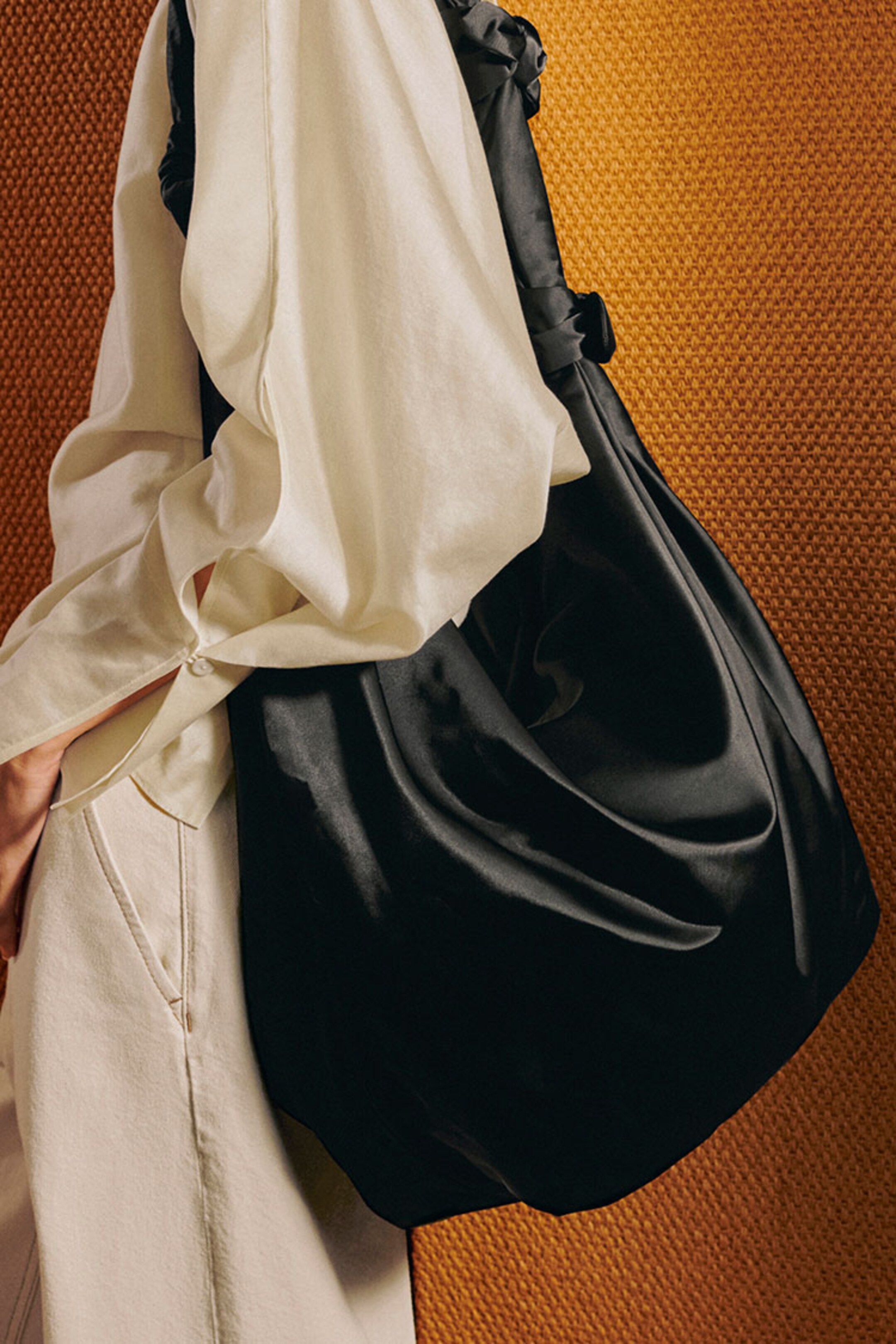Caralarga: seeking raw beauty

As COS opens its first store in Mexico, meet the women-owned textile design workshop highlighting the inherent beauty of raw materials and intertwining the past with the present.
‘THOSE WHO COLLABORATE WITH US AS ARTISANS NOT ONLY LEARN, BUT CAN ALSO TAKE AND APPLY THE KNOWLEDGE ACQUIRED, EITHER BY SHARING IT WITH FUTURE GENERATIONS OR USING IT FOR THEMSELVES.’
ANA HOLSCHNEIDER, FOUNDER & CREATIVE DIRECTOR
It was the discovery of discarded waste from a textile factory that changed everything for creative director Ana Holschneider (she/her). ‘That's how, in 2014, Caralarga was officially born’, she explains. ‘Thanks to this we began experimenting with raw cotton thread in pieces of jewellery.’ A year later, she set up Caralarga’s workshop in the Hércules neighbourhood on the outskirts of Querétaro, Mexico – the storied home of the very factory that inspired it all.
‘The attributes and possibilities of the material made us able to design, play with shapes and use different weaving techniques’, adds master artisan María del Socorro Gasca (she/her). Together, along with operative director Ariadna García (she/her), they seek to preserve the natural beauty of raw materials by transforming them into high-quality artisanal pieces – using every possible scrap of textile waste that lands in their workshop along the way.
What began as a two-person pursuit crafting intricate earrings, necklaces and bracelets from silk and jute thread has evolved into a team of 60 producing large-scale interior pieces that can take up to nine weeks to create, often custom-made for clients around the world.
Inspiration for Caralarga’s artfully woven wall hangings, ceiling lamps and braided rope sculptures comes from Mexican culture and landscapes, both ancient and modern, making them a natural fit for the flagship COS store in Polanco, Mexico City, which celebrates homegrown artisanal craft.
Centred on circular principles such as reuse, recyclability and considered materials, the more sustainably designed concept store aligns with the workshop’s ethos, which is to appreciate the importance of what already exists: ‘to preserve and transmit the value and history of the places, buildings and walls that house us, but also, give a new life to those materials that can be reused instead of using up new resources’, says Ana.
We caught up with the collective to learn more about Caralarga’s traditional techniques, the rich history of Hércules and the consciously crafted artwork that decorates the COS store.

Photograph courtesy of Caralarga

Photograph courtesy of Caralarga

Photograph courtesy of Caralarga

Photograph courtesy of Caralarga
‘WE ALWAYS SEEK TO HIGHLIGHT THE BEAUTY AND SIMPLICITY OF COTTON AND OTHER NATURAL FIBRES.’
ANA HOLSCHNEIDER, FOUNDER & CREATIVE DIRECTOR
HONOURING A LEGACY
AH
‘Having our workshop inside the old textile factory has allowed us to give some continuity to the tradition of working with cotton, but now with an artisanal approach. We honour those 200 years of history and the work of the artisans by using the raw cotton that once was the heart and spirit of this place, even if the materials are no longer the leftovers from the factory.’
A STORIED PAST
AH
‘The old El Hércules textile factory was dedicated to the production of cotton fabrics and fibres since 1838, until it shut down in 2019; Hércules, along with two other textile factories in the area, represented the largest industrial production force in the field, both for Querétaro and Mexico for almost two centuries. The neighbourhood in which it was located took its name from the factory itself; and it is one of the oldest and most traditional in the Querétaro capital, famous for its hardworking people and the colourful murals that dress each street.’
KEEPING CRAFTSMANSHIP ALIVE
AH
‘Learning and inheriting trades and crafts represented an important aspect of Mexican culture and was a source of family pride until a couple of decades ago; unfortunately, this tradition has been slowly fading away. At Caralarga we seek to rescue this type of tradition. We believe that those who collaborate with us as artisans not only learn, but can also take and apply the knowledge acquired, either by sharing it with future generations or using it for themselves.’
HONOURING A LEGACY
AH: ‘Having our workshop inside the old textile factory has allowed us to give some continuity to the tradition of working with cotton, but now with an artisanal approach. We honour those 200 years of history and the work of the artisans by using the raw cotton that once was the heart and spirit of this place, even if the materials are no longer the leftovers from the factory.’
A STORIED PAST
AH: ‘The old El Hércules textile factory was dedicated to the production of cotton fabrics and fibres since 1838, until it shut down in 2019; Hércules, along with two other textile factories in the area, represented the largest industrial production force in the field, both for Querétaro and Mexico for almost two centuries. The neighbourhood in which it was located took its name from the factory itself; and it is one of the oldest and most traditional in the Querétaro capital, famous for its hardworking people and the colourful murals that dress each street.’
KEEPING CRAFTSMANSHIP ALIVE
AH: ‘Learning and inheriting trades and crafts represented an important aspect of Mexican culture and was a source of family pride until a couple of decades ago; unfortunately, this tradition has been slowly fading away. At Caralarga we seek to rescue this type of tradition. We believe that those who collaborate with us as artisans not only learn, but can also take and apply the knowledge acquired, either by sharing it with future generations or using it for themselves.’

Photograph courtesy of Caralarga

Photograph courtesy of Caralarga

Photograph courtesy of Caralarga
‘OUR ARTISANAL TECHNIQUES STARTED FROM BASIC TYPES OF MACRAMÉ THAT WERE DEVELOPED AND ADAPTED TO MEET OUR CREATIVE NEEDS AS OUR PIECES HAVE EVOLVED.’
MARÍA DEL SOCORRO GASCA, MASTER ARTISAN
TIME-HONOURED TECHNIQUES
SG: ‘Our artisanal techniques started from basic types of macramé that were developed and adapted to meet our creative needs as our pieces have evolved.’
AG: ‘We have also developed our own technique called Repurposed, consisting of reusing the remnants of the cotton thread cut from the Large Format pieces to create new ones, thus trying to generate the least amount of waste possible.’
A MORE SUSTAINABLE APPROACH
AH: ‘For us it’s very important to produce while generating the least amount of disposable waste possible; this applies both to the production of artisanal pieces, and to our packaging.’
AG: ‘We also recover all the materials left from production, including cotton thread, cardboard and more, which we reuse to create new pieces, papier-mâché spheres, as well as smaller boxes and packaging. If there is material left that we can no longer reuse, we collect it and deliver it to people or organisations that are responsible for recycling it.’
CRAFT MEETS INNOVATION
AH: ‘Our Innovation department is in charge of experimenting, developing and implementing techniques so we can continue reusing the excess material in our creative and original pieces. As a team, we try to be more aware of our habits and how these can be used in the way we work, being aware of the material we use and how we treat it to make the most out of it without wasting it.’
THE COS STORE DESIGNS
AH: ‘Three variations of our Colmena Large Format will live in the COS store. For this design we were inspired by the beehive and its architecture, which is formed by geometrically perfect cells. We abstracted and replicated this pattern using cotton thread and papier-mâché spheres that fit in harmonious symmetry, mirroring not only the aesthetics but also the hard work of the bees in the careful craftsmanship of the artisans.’
Words by Brittany Du-Crow




